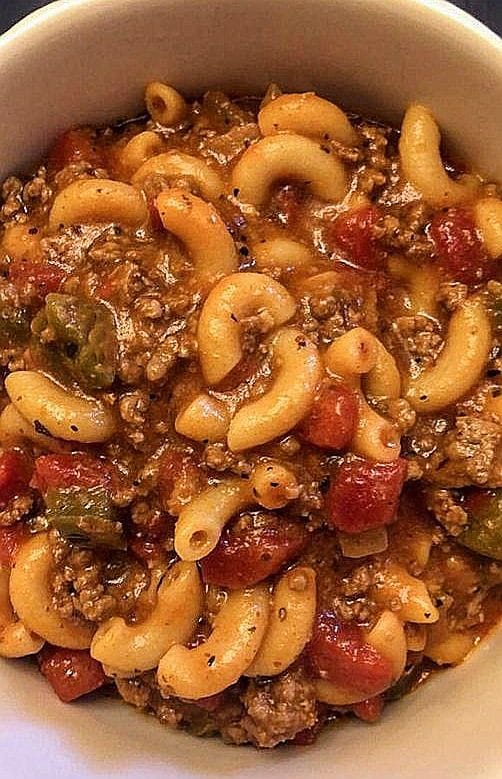ground beef and pasta.
Carbohydrates: Approximately 45-55 grams of carbohydrates per serving, mainly from the pasta and tomato sauce.
Dietary Fiber: Roughly 4-6 grams of dietary fiber per serving, depending on the type of pasta used.
Sugars: Approximately 5-8 grams of sugar per serving, primarily from the natural sugars in the tomatoes and tomato sauce.
Fats: Approximately 15-20 grams of total fat per serving, with most of it coming from the ground beef and any added cooking oil.
Saturated Fat: Around 5-8 grams of saturated fat per serving, primarily from the ground beef.
Cholesterol: Approximately 40-60 milligrams of cholesterol per serving, mainly from the ground beef.
Sodium: Roughly 800-1000 milligrams of sodium per serving, with variations based on the salt content of the ingredients and seasonings used.
Vitamins and Minerals: Mom’s Goulash provides essential nutrients like vitamin C from the tomatoes, as well as iron, B vitamins, and potassium from the beef and pasta. It’s a balanced meal that offers a mix of macronutrients and micronutrients.
Note: These nutritional values are approximate and can vary based on factors like the specific brands of ingredients used and portion size. Mom’s Goulash is a filling and satisfying dish, often enjoyed for its comforting flavors. It provides a decent amount of protein and carbohydrates, making it a hearty meal. To make it even more nutritious, consider adding vegetables or whole wheat pasta to increase fiber content and vitamins.
Mom’s Goulash, like many traditional comfort food recipes, has a history rooted in the kitchens of families who passed it down through generations. While it may not have a specific origin story or a famous creator, it holds a special place in the hearts and memories of those who have enjoyed it for years.
Here’s a glimpse into the historical context of goulash and its evolution into the beloved dish known as Mom’s Goulash:
1. Goulash Origins: Goulash, the dish that serves as the foundation for Mom’s Goulash, has its roots in Central Europe, particularly Hungary. Traditional Hungarian goulash, known as “gulyás” in Hungarian, is a hearty stew made with chunks of beef, paprika, onions, and other seasonings. It has been a staple in Hungarian cuisine for centuries and was originally prepared by Hungarian herdsmen (known as “csikós”) as a convenient and filling meal.
2. Adaptation and Americanization: As Hungarian immigrants settled in the United States in the late 19th and early 20th centuries, they brought their culinary traditions with them. Over time, goulash recipes began to evolve and adapt to local ingredients and tastes. Ground beef, which was more readily available and affordable in the United States, became a common substitute for the traditional chunks of beef.
3. Family Recipes: Mom’s Goulash, much like its name suggests, likely originated in American households, where mothers and grandmothers put their own spin on traditional goulash recipes. These family recipes were passed down through the generations and often varied from one household to another, depending on individual preferences and regional influences.
4. Comfort Food Classic: Mom’s Goulash embodies the essence of comfort food—a warm, hearty, and familiar dish that brings comfort and nostalgia. It became a popular choice for family dinners, potlucks, and gatherings due to its affordability, ease of preparation, and crowd-pleasing flavors.
5. Cultural Significance: While Mom’s Goulash may not have a specific historical figure or event associated with its creation, it is a representation of how culinary traditions are passed down and adapted over time. It showcases the influence of Hungarian cuisine on American cooking and the importance of family recipes in preserving cultural heritage.
Today, Mom’s Goulash remains a beloved dish, often enjoyed for its simple yet satisfying combination of ground beef, pasta, and a flavorful tomato sauce. It continues to evoke warm memories of family gatherings and the comforting embrace of home-cooked meals. Whether it’s called “Mom’s Goulash” or a similar name in different households, it is a testament to the enduring legacy of family recipes and the joy they bring to our dining tables.

